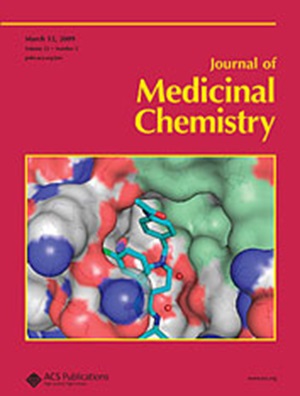3-Hydroxyquinolin-2-Ones Act as Dual Inhibitors of Ferroptosis and Monoamine Oxidase B: Reducing Alzheimer’s Disease-Related Amyloid Precursor Protein and Hyperphosphorylated Tau In Vivo
IF 6.8
1区 医学
Q1 CHEMISTRY, MEDICINAL
引用次数: 0
Abstract
The challenges in the current treatment landscape for Alzheimer’s disease (AD) underscore the urgent need for novel therapeutic strategies targeting multiple pathological pathways. Recent studies have implicated iron in ROS-dependent neuronal injury through ferroptosis. Additionally, overexpression of monoamine oxidase B (MAO-B) induces oxidative stress and decreases cognitive function. In this study, we presented the novel dual inhibitors of ferroptosis and MAO-B for AD management, aiming to address both the symptomatic and neurodegenerative aspects of this disease. Compound 21d emerged as a promising candidate, exhibiting potent and selective MAO-B inhibitory activity (IC50 = 87.47 nM, SI > 229), as well as excellent antiferroptosis activity through modulation of the iron metabolic pathway and GSH-GPX4 axis in vitro. Importantly, 21d normalized cognitive and memory impairments in a 3×Tg (APP/Tau/Ps1) AD mouse model and reduced levels of AD-related proteins, including amyloid precursor protein and phosphorylated Tau protein, in the brains of AD mice.

3-羟基喹啉-2- 1作为铁中毒和单胺氧化酶B的双重抑制剂:体内降低阿尔茨海默病相关淀粉样前体蛋白和过度磷酸化的Tau
当前阿尔茨海默病(AD)治疗领域的挑战强调了迫切需要针对多种病理途径的新型治疗策略。最近的研究表明铁通过铁下垂参与ros依赖性神经元损伤。此外,单胺氧化酶B (MAO-B)的过度表达诱导氧化应激,降低认知功能。在这项研究中,我们提出了新的双抑制剂铁下垂和MAO-B的AD管理,旨在解决这一疾病的症状和神经退行性方面。化合物21d表现出较强的选择性MAO-B抑制活性(IC50 = 87.47 nM, SI >;229),以及通过调节铁代谢途径和GSH-GPX4轴在体外具有优异的抗铁下垂活性。重要的是,在3×Tg (APP/Tau/Ps1) AD小鼠模型中,21d使认知和记忆障碍正常化,并降低了AD小鼠大脑中AD相关蛋白(包括淀粉样蛋白前体蛋白和磷酸化Tau蛋白)的水平。
本文章由计算机程序翻译,如有差异,请以英文原文为准。
求助全文
约1分钟内获得全文
求助全文
来源期刊

Journal of Medicinal Chemistry
医学-医药化学
CiteScore
4.00
自引率
11.00%
发文量
804
审稿时长
1.9 months
期刊介绍:
The Journal of Medicinal Chemistry is a prestigious biweekly peer-reviewed publication that focuses on the multifaceted field of medicinal chemistry. Since its inception in 1959 as the Journal of Medicinal and Pharmaceutical Chemistry, it has evolved to become a cornerstone in the dissemination of research findings related to the design, synthesis, and development of therapeutic agents.
The Journal of Medicinal Chemistry is recognized for its significant impact in the scientific community, as evidenced by its 2022 impact factor of 7.3. This metric reflects the journal's influence and the importance of its content in shaping the future of drug discovery and development. The journal serves as a vital resource for chemists, pharmacologists, and other researchers interested in the molecular mechanisms of drug action and the optimization of therapeutic compounds.
 求助内容:
求助内容: 应助结果提醒方式:
应助结果提醒方式:


